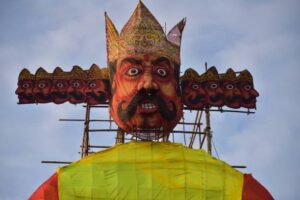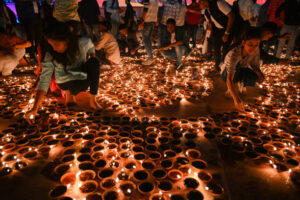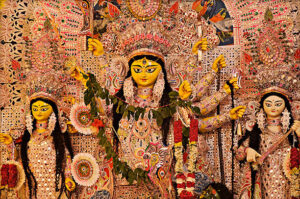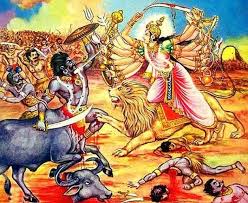OVERVIEW

Dussehra, also known as Vijayadashami, is a vibrant Hindu festival celebrated across India, symbolizing the victory of Lord Rama over the demon king Ravana the King of Lanka .It is also celebrated to mark the victory of Goddess Durga over demon Mahishasur and end of Navratri. This year, Dussehra falls on October 12, 2024, and it marks the end of the nine-day Navratri festival. Dussehra not only marks the win of good over bad but also unites different communities various rituals, fairs, and dramatic performances inviting everyone to take part in joyful celebrations.
Dussehra 2024 : Date and Time
According to Hindu calendar this is celebrated on Dashami Tithi of Shukla Paksha in month of Ashwini every year i.e. , 12th October if this year 2024
Time:
Dashami Time start: 12 October 2024 10:58 AM
Dashami end date:13 October 2024 9:08 AM
SIGNIFICANE OF DUSSHERA
Dussehra is one of major festival of HINDUS, which is celebrated across the country with great pomp and show to symbolize the win of RAJA RAM of ayodha over the demon king of lanka RAVANA .

-
Lord Rama, the seventh avatar of Vishnu, is depicted as the ideal man and king. He is exiled to the forest along with his wife, Sita, and brother, Lakshmana, due to a promise made by his father, King Dasharatha.
-
Abduction of Sita: During their exile, Ravana, the powerful demon king of Lanka, abducts Sita, seeking revenge against Rama and demonstrating his evil nature.
-
The Battle: Rama, with the help of allies like Hanuman and the army, sets out to rescue Sita. The climax of their struggle occurs in a fierce battle where Rama kills Ravana.
-
Victory of Good: Rama ultimately defeats Ravana, symbolizing the triumph of good over evil. This victory teaches the values of courage, loyalty, and the importance of adhering to one’s dharma.
-
Celebration of Dussehra: The festival celebrates this victory, reminding devotees that righteousness prevails even in the face of great adversity. The burning of Ravana’s effigy represents the destruction of evil forces and the hope for a just world.
In addition to the story of Lord Rama and Ravana , Dussehra is also significant in the context of Goddess Durga’s victory over the buffalo demon Mahishasura . This narrative highlights themes of feminine power and the triumph of good:
-
Background of Mahishasura: Mahishasura, a demon with the ability to change forms, terrorizes the gods and disrupts the cosmic order. Unable to defeat him, the gods unite and invoke the goddess for help.
-
Creation of Goddess Durga: In response, the gods collectively create Goddess Durga, an embodiment of strength and divinity, equipped with weapons and powers from various deities.
-
The Battle: Durga confronts Mahishasura in an epic battle that lasts for nine days and nights, symbolizing the struggle against evil. Each day of Navaratri, celebrated leading up to Dussehra, honors different aspects of the goddess and her power.
-
Victory: On the tenth day, known as Vijayadashami or Dussehra, Durga defeats Mahishasura, restoring balance and righteousness. This victory signifies the power of the divine feminine and the importance of courage and resilience in overcoming obstacles.
-
Cultural Significance: The festival celebrates not only the victory of Durga but also serves as a reminder of the inner strength within everyone to combat evil and injustice. The themes of empowerment, protection, and the celebration of femininity resonate deeply in various cultural practices across India.
Thus, Dussehra encapsulates both the stories of Lord Rama and Goddess Durga
Themes of Dussehra
-
Good vs. Evil
The central narrative of Dussehra revolves around the battle between Lord Rama and the demon king Ravana, symbolizing the triumph of righteousness over malevolence. This theme inspires individuals to uphold moral values in their lives.
-
Righteousness (Dharma)
Dussehra emphasizes the importance of dharma, encouraging people to adhere to ethical principles and fight against injustice, much like Lord Rama did.
-
Cultural Unity
The festival brings together diverse communities, transcending regional, linguistic, and cultural differences. It serves as a reminder of the shared values of love, compassion, and harmony.
-
Celebration of Victory
Dussehra is not just about the defeat of evil but also a celebration of hope, resilience, and the potential for renewal in the face of challenges.
-
Community and Family Bonds
The festivities encourage gatherings of family and friends, strengthening community ties and fostering a sense of belonging.
CELEBRATION in different parts of country
Dussehra is celebrated across India in various ways, reflecting regional traditions and cultural nuances. Here’s a glimpse of how it is observed in different states:
1. Uttar Pradesh
Ramlila Performances: Elaborate enactments of the Ramayana are held, culminating in the burning of Ravana’s effigies.

Ayodhya Celebrations: As the birthplace of Lord Rama, Ayodhya hosts grand celebrations, including lighting lamps along the banks of the Sarayu River.

2.West Bengal
Durga Puja: Dussehra coincides with the last day of Durga Puja, celebrating Goddess Durga’s victory over Mahishasura.
Immersion Processions: Idols of Durga are immersed in rivers or the sea, accompanied by music, dance, and festivities.
3. Maharashtra
Ganesh Visarjan: In some regions, Dussehra also involves the immersion of Ganesh idols.

Festive Feasts: Families come together to celebrate with special foods, sweets, and community gatherings.
4. Karnataka
Navaratri Celebrations: The festival is celebrated with Golu, where dolls and figurines are arranged on steps.

Cultural Programs: Music and dance performances take place, showcasing traditional art forms.
5. Gujarat
Navratri Garba: The festival is celebrated with energetic Garba and Dandiya dance, honoring Goddess Durga.
Community Events: People participate in vibrant community gatherings, wearing traditional attire.
6. Tamil Nadu
Bommai Kolu: Dolls are displayed on steps, representing various themes, and families exchange gifts.
Pooja Rituals: Special prayers and rituals are conducted in homes and temples.
7. Punjab
Dussehra Melas: Fairs are organized with rides, food stalls, and cultural performances.
Effigy Burning: In some areas, effigies of Ravana are burned, accompanied by fireworks.

8. Odisha
Durga Puja: Similar to West Bengal, it features grand decorations and processions, with idols of Durga being worshiped.
Cultural Shows: Traditional dances and music are integral to the celebrations.
9. Himachal Pradesh
Kullu Dussehra: This unique celebration involves a week-long festival with traditional rituals, cultural performances, and the procession of deities.
10. Assam
Bihu Dance: In some areas, the festival is linked with Bihu celebrations, highlighting folk music and dance.

Overall, while the essence of Dussehra as a celebration of good over evil remains constant, the local customs, rituals, and festivities vary, making it a rich and diverse cultural experience across India.
How we can make DUSSEHRA 2024 special:
As we celebrate Dussehra, it’s essential to keep our environment in mind.


